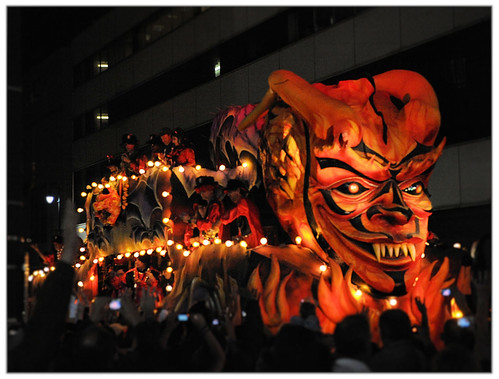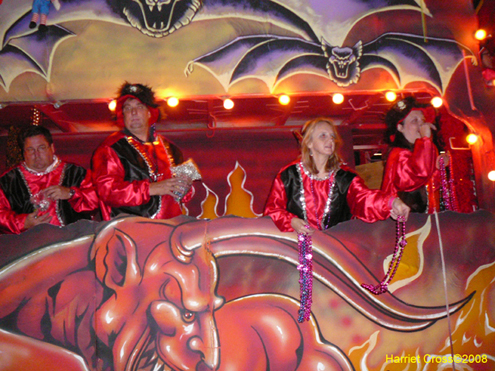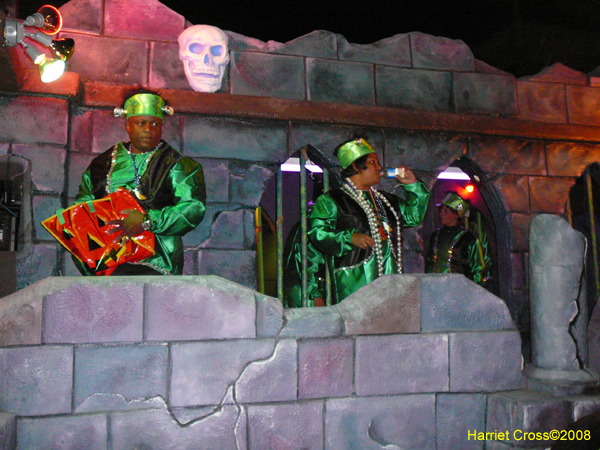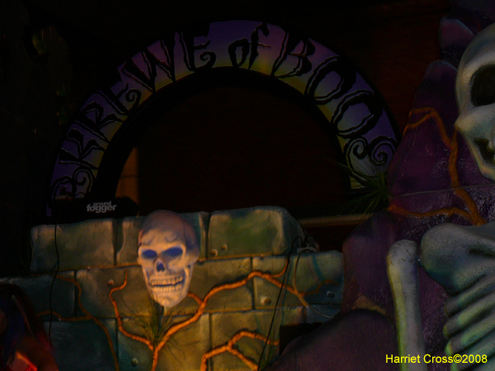Among the parade's signature features are its pageant sized puppets — giant rod puppets "articulated" by teams of puppeteers — and its open participation to anyone in a costume who wishes to march. It is the largest public Halloween event in the United States, and the country's only major night parade. It has been called "New York's Carnival." Although the parade is currently not as informal and wild as it was in its earliest years, it is in effect still an alternative festival.
The Village Halloween Parade was founded in 1974 by Ralph Lee, working with George Bartenieff and Crystal Field of the Theater for the New City, which produced the parade for the first two years. The idea was to create a mile-long theatrical event of masked performers, giant puppets and musicians that moved through the streets, and to populate elements of the environment along the way with additional flamboyant characters. Through other theatrical productions, Lee had accumulated over 100 masks and giant puppets, all of which were put to service in the first parade. Colleagues and acquaintances of Lee, along with friends and family, donned these creations and performed with them as the parade wound through the narrow streets of Greenwich Village from West Street to Washington Square. This curious spectacle took local residents by surprise; many were drawn to the extraordinary liberation of the streets and joined in the festivities.
Due to its popularity, the parade was staged again in 1975. More revelers joined in—approximately 1,500 in all—and a ragtag Vaudeville show was added in Washington Square. That year Lee received a Village Voice OBIE Award; calling the parade "an event of startling theatrical imagination," the award was given "to recognize its artistic achievement and to encourage it to become an annual tradition."
In 1976 the parade obtained its own not-for-profit status, and a core production staff was formed. Logistics were coordinated through Community Board 2, the Parks Department and the Police Department's 6th Precinct. Artists went into the schools to create giant puppets with children for the parade. Musical groups were enlisted: pick-up bands, samba bands, Dixieland, Italian, Chinese, Irish, African, steel bands. These groups provided the heartbeat of the parade. Increasingly, more individuals participated dressed in their own fantasies. Bystanders could watch from the sidelines or join the procession.
Starting in 1977, the parade route traversed 10th Street from Greenwich Avenue to 5th Avenue, entering Washington Square through the Arch. Jefferson Market Library was transformed into a haunted fortress, with a twelve-foot spider crawling up and down the clock tower. On 10th Street, the balconies of Renwick Row became the setting for a gathering of grotesque sophisticates. Washington Square Arch provided another lofty stage. A fat devil appeared up on top, waved to the crowds and released a cascade of balloons; then a dummy of the devil slid down a wire to the middle of the fountain area below. Joel Oppenheimer captured the spirit of the parade that year in the Village Voice:
"This was a huge and good and happy gathering of all of us, grown-ups and children, men and women, straights and gays, blacks and whites, all the dualities out there, holding off the darkness and the ghosts, and saying Goodbye, Sun, see you next year."
With the size of the parade having reached over 250,000, in 1985 the route was moved out of the narrow streets of the West Village and onto 6th Avenue. After the 1985 parade, Ralph Lee stepped down from his position as director, stating, "The parade has always been a celebration of the individual imagination in all its infinite variety. It continues to provide a framework for this expression and invites the participation of everyone." Subsequently Jeanne Fleming, who had been working on the parade for three years, took over as director. Fleming continues to manage the parade today. Another distinct feature of the Village Halloween Parade is its costumes, which are limitless in their variety, "bizarre but brilliant" (Fodor's), well-crafted, and highly entertaining. New York is a world center of the visual and performing arts; fashion and costume design; pop-culture; publicity and marketing; communications, education, literature and publishing; and film, theatre and television. Its population is a rich source of pageant devotees who possess the many talents necessary to create the costumes, puppets, performances, and other artistic presentations. Greenwich Village in particular is home to its own brand of bohemian, pagan, counterculture, exotic and erotic costumes, designed by attention-seekers who have gone to great lengths to outdo each other, and pleasure-seekers determined to have fun. Straightforward, everyday Halloween costume fare — monsters, witches, aliens, pirates, cartoon and storybook characters, animals, royalty and celebrities — are easily upstaged by the unpredictable variety of creations that sometimes defy description. The key to the competition seems to be to come up with a one-of-a-kind, entertaining idea, execute it cleverly, and address the costume's technical and artistic challenges. Simple but clever also works, as well as the absurd juxtaposing of unrelated ideas. There is also strength in numbers in this parade; one may be overlooked dressing like Richard Simmons, but twenty Simmons look-alikes, in wigs and hot pink shorts, cannot fail to attract attention.
The Village Halloween Parade was founded in 1974 by Ralph Lee, working with George Bartenieff and Crystal Field of the Theater for the New City, which produced the parade for the first two years. The idea was to create a mile-long theatrical event of masked performers, giant puppets and musicians that moved through the streets, and to populate elements of the environment along the way with additional flamboyant characters. Through other theatrical productions, Lee had accumulated over 100 masks and giant puppets, all of which were put to service in the first parade. Colleagues and acquaintances of Lee, along with friends and family, donned these creations and performed with them as the parade wound through the narrow streets of Greenwich Village from West Street to Washington Square. This curious spectacle took local residents by surprise; many were drawn to the extraordinary liberation of the streets and joined in the festivities.
Due to its popularity, the parade was staged again in 1975. More revelers joined in—approximately 1,500 in all—and a ragtag Vaudeville show was added in Washington Square. That year Lee received a Village Voice OBIE Award; calling the parade "an event of startling theatrical imagination," the award was given "to recognize its artistic achievement and to encourage it to become an annual tradition."
 New Orleans Halloween Parade |  Back to Halloween festival |  New Orleans Halloween Parade |  2010 KREWE OF HALLOWEEN New |  New Orleans Halloween Parade |
 gamelons, New Orleans jazz |  Krewe-of-Boo-New-Orleans- |  Krewe Of Boo Halloween Parade, | Halloween parades are supposed |  Parade In New Orleans |
"This was a huge and good and happy gathering of all of us, grown-ups and children, men and women, straights and gays, blacks and whites, all the dualities out there, holding off the darkness and the ghosts, and saying Goodbye, Sun, see you next year."
 Parade In New Orleans |  Blaine Kern\x26#39;s Krewe of |  Parade In New Orleans |  Parade In New Orleans |  Parade In New Orleans |
Halloween came a little early |  We have a new meeting place: |  KREWE OF BOO HALLOWEEN PARADE |  back to New Orleans First |  Village Halloween Parade |














No comments:
Post a Comment